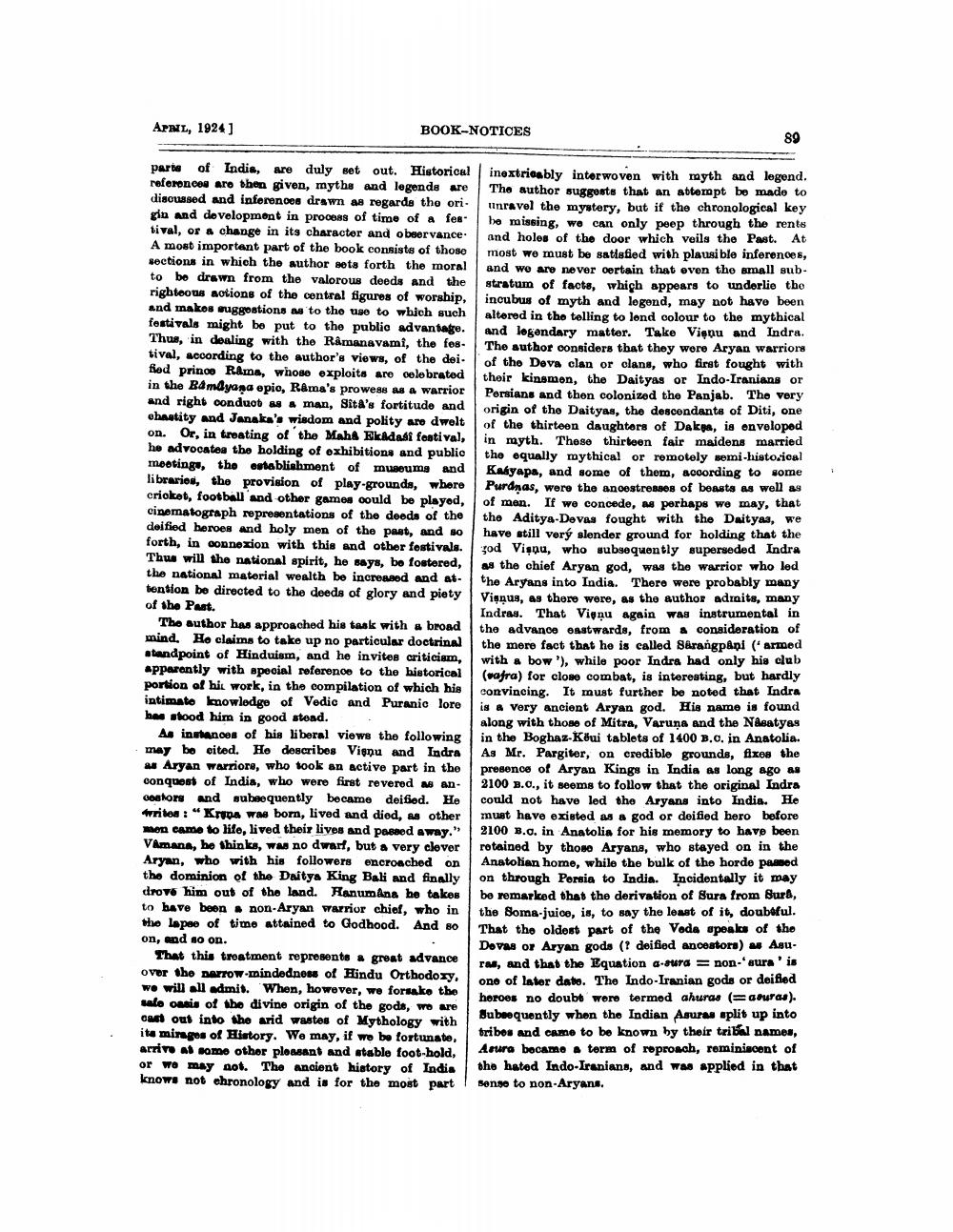________________
APNL, 1924 ]
BOOK-NOTICES
parts of India, are duly set out. Historical references aro bhen given, myths and legends Are discussed and inferences drawn as regards tho ori. glu and development in process of time of a fes tival, or a change in its character and obeervance. A most important part of the book consists of those sections in which the author sets forth the moral to bo drawn from the valorous deeds and the righteous aotions of the central figures of worship, and makes muggostions as to the rise to which such festivals might be put to the publio advantage.
puono advantage Thus, in dealing with the Råmanavami, the fostival, according to the author's views of the dei. fied prince Rama, whose exploits are celebrated in the Bdmdyana epio, Rema's prowess as a warrior and right oonduot eg #man, Sita's fortitudo and ebastity and Janaka's wisdom and polity are dwelt on. Or, in treating of the Maha Ekadasi festival, he advocates the holding of exhibitions and public mooting, the stablishment of museums and librarios, the provision of play.grounds, whore criokot, football and other games could be playod, cinematograph representations of the deeds of the deifiod beroes and holy men of the past, and so forth, in connexion with this and other fostivals. Thus will the national spirit, he says, bo fostered, the national material wealth be increased and attention be directed to the deeds of glory and piety of the Past.
The author has approached his task with a broad mind. He claims to take up no particular doctrinal standpoint of Hinduism, and he invites criticism, apparently with special reference to the historical portion of hit work, in the compilation of which his intimato knowledge of Vedic and Puranic lore has stood him in good stead. .
As instances of his liberal views the following - may be oitod. He describes Vienu and Indra
a Aryan warriore, who took an active part in the con quest of India, who were first revered as an Gestors and subeequently became deified. He writon: "Kripa was born, lived and diod, as other mon came to kito, lived their lives and passed away." VAmana, he thinks, was no dward, but a very clover Aryan, who with his followers encroached on the dominion of the Daitya King Bali and finally drove him out of the land. Hanumana he takes to have been non-Aryan warrior chief, who in the lapee of time attained to Godhood. And so on, and so on.
That this treatment represents # great advance over the narrow-mindedness of Hindu Orthodoxy. we will all admis. When, however, we forsake the salo oasis of the divine origin of the gods, we are Got out into the arid wastes of Mythology with ita mirages of History. We may, if we be fortunate, arrive at some other pleasant and stable foot-hold, or we may not. The ancient history of India knows not chronology and is for the most part
inextricably interwovon with myth and legend. The author suggests that an attempt be made to Unravel the mystery, but if the chronological key he missing, we can only peep through the rente and holes of the door which veils the Past. At most we must be satisfied with plausible inference, and we are never oertain that even the small substratum of facte, which appears to underlio the incubus of myth and logond, may not have been altered in the telling to lond colour to the mythical and logondary matter. Take Vippu and Indra. The author considers that they were Aryan warriors of the Deva clan or clans, who first fought with their kinsmon, the Daityas or Indo-Iranians or Persians and then colonized the Panjab. The very origin of the Daityas. the descendants of Diti, one of the thirteen daughters of Dak, ia enveloped in myth. These thirteen fair maidens married the equally mythical or remotely semi-historical Kayapa, and some of them, according to some Purdnas, were the anoestrosses of boasts as well as of mon. If we concede, s perhaps we may, that the Aditya Dovas fought with the Daityas, we have still very slender ground for holding that the god Vipau, who subsequently superseded Indra as the chief Aryan god, was the warrior who led the Aryans into India. There were probably many Virņus, as there were, as the author adroits, many Indras. That Vienu again was instrumental in the advance oastwards, from a consideration of the more fact that he is called Sarangpapi ("armed with a bow'), while poor Indra had only his club (vafra) for close combat, is interesting, but hardly convincing. It must further be noted that Indra is * Very ancient Aryan god. His name is found along with those of Mitra, Varuna and the Nesatyas in the Boghaz-Köui tablets of 1400 B.o. in Anatolia. As Mr. Pargiter, on credible grounds, fixes the presence of Aryan Kings in India as long ago as 2100 B.C., it seems to follow that the original Indra could not have led the Aryans into India. He must have existed as a god or doified hero before 2100 B.o. in Anatolia for his memory to have been rotained by thoso Aryans, who stayed on in the Anatolian homo, while the bulk of the horde pened on through Persia to India. Incidentally it may be remarked that the derivation of Sura from Bura, the Soma-juico, is, to say the least of it, douboful. That the oldest part of the Voda spoalas of the Dovas or Aryan gods (deified ancestors) - Asu. rm, and that the Equation a-sura = non'aurais one of later dato. The Indo-Iranian gods or deifled horoos no doubt were termod ahuras (=aduras). Subeoquently when the Indian Asuras split up into tribes and came to be known by their tribal names, Anura became term of reproach, reminiscent of the hated Indo-Iranians, and was applied in that senso to non-Aryans.




